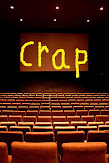The function of this metric seems intuitive: If the movie appeals to a wide variety of people then it has a better chance of appealing to academy voters and therefore has better chances for a Best Picture Oscar. Rottentomatoes is the very best resource for such information and has been for a decade.
However, the statistic is not as simple as High=good, low=bad. If such things were true, then documentaries and animated films would dominate the awards festivities. Certainly if a film falls below a certain level of broad appeal, you can count them out. But is there a ceiling to the broad appeal metric to go with the floor? There is some statistical data that says: yes.
Contention Threshold
There is a clearly demarcated line at which a film no longer becomes a contender. I like to call it the "ligne chocolat" because it is set by Lasse Halstrom's charming film Chocolat which garnered a puny 62%. Anything below this would require some super mojo to overcome. This line eliminates a large number of films. Chocolat's mojo was called Harvey Weistein in his heyday.
Also, there is a low water mark for Oscar Winners as well that I'd like to call the "Crash Barrier" because it was set by Paul Haggis' controversial film "Crash" which claimed only 75% broad appeal, the lowest for an oscar winner in the past decade. Love it or hate it, one must recognize Crash as an event film with unprecedented appeal. It's still the #1 most rented film on Netflix. So any film that falls below the "Crash Barrier" better have something extra special working.
Too good to win?
It seems strange to contemplate, but only 7 of the last 50 nominated films were rated above 95% on Rottentomatoes: only 14%. Of those 7, none of them won. It seems if a film reaches that upper 5 percentile its chances decrease greatly. Why is this? Perhaps a great number of those films are animated and documentary films and therefore are transported to their own separate categories.
But what of the live action fiction films that do get nominated but cannot win? My educated guess is that the film's broad appeal can have a downfall. If it appeals to almost everyone, then perhaps it does not risk enough to be truly loved as opposed to simply admired.
Oscar Profile
The average oscar nominee has an RT score in the mid-80s whereas the average winner's score is in the late 80s to early 90s. In terms of broad appeal the nominee range is a very broad 62-96 and the winners range is 75-94. Tomorrow I'll take a look at what films we can eliminate from competition based solely on this metric.
Magic Number?
One curious thing I noticed while pouring over this data is that the mode, or most frequently occurring number, of both the nominees and the winners was the same, and it was a very high number: 94. It may be a useless statistic, but, just for fun, let's say it isn't. Guess what film is currently sitting pretty at the very popular percentage of 94: Box office champ and critical darling "The Dark Knight."
Raw Data
mean
winners: 87
nominees: 86
median
winners:90
nominees: 87
mode
both: 94
Sunday, November 30, 2008
The Oscar Formula: Broad Appeal
Labels:
The Oscar Formula
Subscribe to:
Post Comments (Atom)

0 comments:
Post a Comment